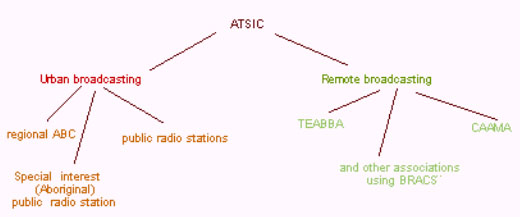|
The
Aboriginal and Torres Strait Islander Commission (ATSIC)
provides most of the funding for Aboriginal and Torres
Strait Islander broadcasting.
Aboriginal
and Torres Strait Islander broadcasting is an important
element in the promotion and protection of Aboriginal
and Torres Strait Islander cultural identity.
At
present, activities relating to Aboriginal and Torres
Strait Islander broadcasting are considered under four
broad headings for policy and funding purposes:
- Aboriginal
and Torres Strait Islander regional media resource
groups;
- Broadcasting
for Remote Aboriginal Communities Scheme (BRACS);
- Aboriginal
and Torres Strait Islander public broadcasting; and
- Aboriginal
and Torres Strait Islander involvement in mainstream
broadcasting.
(ATSIC, 1993: 21)
There
are two types of Aboriginal and Torres Strait Islander
community broadcasting:
Broadcasting
in urban areas
Urban Aboriginal broadcasting consists of radio
programs produced by Aboriginal or Torres Strait Islander
media groups and broadcast through regional ABC radio,
public radio stations or less frequently through a Special
Interest (Aboriginal) public radio station.
Broadcasting
in remote areas
Aboriginal
and Torres Strait Islander people form a significant
proportion of the population of remote Australia.
The inhabitants of remote Australia are comparatively
under-served by the media, even taking into account
satellite-delivered services. The major growth in
Aboriginal and Torres Strait Islander broadcasting
has been in remote regions, with a large number of
media associations operating their own community television
and radio services with equipment provided under the
Broadcasting from Remote Aboriginal Communities Scheme
(BRACS). (ATSIC, 1993: 8)
Why is there a need for Aboriginal and Torres Strait
Islander broadcasting?
In
general, the larger number of mainstream television
and radio channels available in urban centres seldom
reflect Aboriginal and Torres Strait Islander information
needs and interest. These stations are geared towards
mass audiences and cannot provide satisfactory access
for smaller sub-groups in the community such as Aboriginal
and Torres Strait Islander people.
(ATSIC, 1993: 7)
Ideally
Aboriginal and Torres Strait Islander issues should
be presented by Aboriginal and Torres Strait Islander
people themselves. It is not only the content that is
important but also the manner in which it is presented.
ATSIC
believes there are a number of reasons why there should
be greater access to media by Aboriginal and Torres
Strait Islanders, such as:
- educational
needs
- equity
- enhance
self-image
- cultural
preservation and growth
- efficient
communication
- training
and development opportunities.
Activity
| 1. |
What
do the following acronyms stand for?
ATSIC
BRACS
TEABBA |
| 2. |
Draw
and label a diagram to illustrate how BRACS fits
into Aboriginal and Torres Strait Islander broadcasting.
A suggested framework is provided for you. |

Overview
of BRACS |
| 3. |
State
the five main reasons why ATSIC believes there
should be greater access to media by Aboriginal
and Torres Strait Islander people. |
| 4. |
State
the five main reasons why ATSIC believes there
should be greater access to media by Aboriginal
and Torres Strait Islander people. |
| 5. |
Explain
why there is a need for special interest community
radio. |
|